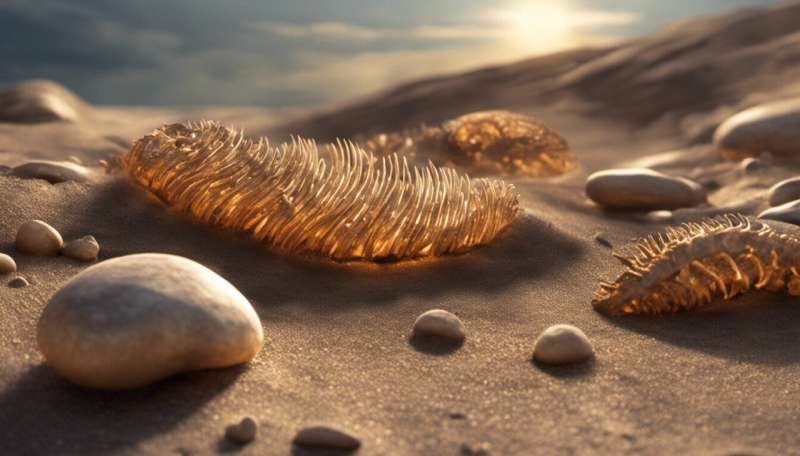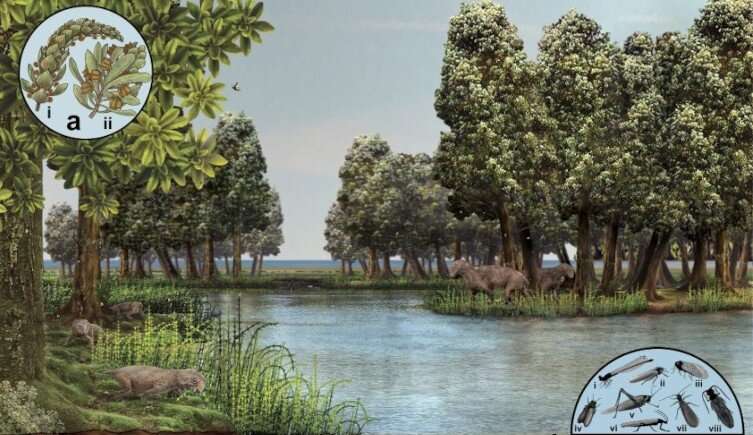South African fossils reveal the lost world of ancient invertebrates

A former South African quarry is opening a window into an important period in the history of life.
The discovery of fossilized invertebrates at the site, including what could be the earliest body fossil of a leech, is revealing the hidden diversity of the Permian period, while other fossils from the quarry have helped to solve a long running botanical mystery.
When it comes to fossils, it's normally the big animals that get the most attention. But a site in South Africa is showing that small finds can be impressive too.
Though they remain to be described in detail, the fossils found at the newly revealed site, known as Onder Karoo, appear to set a number of firsts. They include what may be the earliest-known freshwater leech, and exquisitely preserved water mites—pushing back the confirmed occurrence of this group of arachnids by 150 million years.
Together, these fossils help to fill in the gaps around the large animals we know existed in the past, and create a picture of what they would have seen and experienced.
Dr. Rosemary Prevec, who has led a new paper detailing discoveries at the site, says, "The fossils we are finding are very ancient but are beautifully preserved. This includes very fine details like the hairs and veins of insect wings, the gut contents of insects, and soft animals and plants which aren't often preserved well."
"Together, the site provides a close-up and detailed look at an ancient ecosystem, rather like holding up a magnifying glass to one small part of the world as it was many millions of years ago."
Dr. Mike Day, the Curator of Non-Mammalian Tetrapods at the Museum who co-authored the research, adds, "Onder Karoo is a unique site, and there really is nothing else like it from elsewhere in Gondwana at that time."
"The preservation of invertebrates and plants is generally very poor in the southwestern Karoo Basin. The rock layer at the new locality was deposited in a calm and shallow pool on the shores of the Karoo Sea, which provided excellent conditions for the preservation of small and delicate plants and animals."
The findings of the study were published in the journal Communications Biology.

What has been found at Onder Karoo?
The site was first discovered during a search for fossilized plants in the Sutherland region of South Africa's Northern Cape province in 2009. After coming up empty handed, a change of scenery revealed promising signs for the discovery of fossils.
"As we drove along a small dirt road, a rock outcrop came into view that was unlike anything we had seen in the area," Rosemary recalls. "The fine layering, its particular color and texture of the rock were ideal for finding plant fossils. Within minutes of digging, we were finding insect and plant fossils, and I knew this was something very special."
Across 10 weeks of fieldwork conducted over several years, the former quarry revealed thousands of plant and insect fossils dating back around 266 million years to the middle Permian. All this time ago, the quarry is thought to have been part of a lake fed by a river emptying into the Karoo Sea.
The lake would have provided the perfect breeding ground for a range of invertebrate life, including short-lived insects such as stoneflies and damselflies. Fossils found at the site are the oldest examples of these animals found in Gondwana, a supercontinent today split into South America, Africa, Australasia and Antarctica.
The lake would have been surrounded by a forest full of mosses, liverworts and Glossopteris, an early tree that dominated the southern hemisphere during the Permian.
Despite being common, we still didn't know what kind of plant Glossopteris was, and it was often considered to be a type of plant known as a seed fern. Dense clusters of male and female cones found at Onder Karoo reveal it was actually a conifer, a group that also contains modern plants such as pine trees and sequoia.
These findings are helping to build a better picture of what ecosystems were like in the middle Permian between 273 and 260 million years ago.
Why is it important to understand the middle Permian?
The Permian is an important turning point in the history of life on this planet, with many important animal groups rising to prominence in this time.
Sharks become dominant predators in the oceans for the first time following a mass extinction that killed many of their competitors, while the ancestors of tortoises and gliding reptiles were also appearing.

Our own ancestors were also present in the form of a dominant group of animals known as synapsids. In the middle Permian, a type of synapsid known as the therapsids evolved, with one branch of this group eventually giving rise to the mammals.
Characteristics that define the mammals, such as warm-bloodedness and mammal-like teeth, would start appearing in the Late Permian and Early Triassic.
"The Karoo Basin is very important for studying the Permian, particularly in regards to the vertebrates," Mike says. "It's one of the main sources of fossils in the record of vertebrates at this time, especially in Gondwana, but also for the supercontinent of Pangaea as a whole."
Non-vertebrates from the middle Permian, however, are much less well known. This means that we know relatively little about the kinds of plants that these animals would have been eating, the pests they might have faced, and creepy-crawlies that sustained their ecosystems."
"While people have been looking for vertebrate fossils in the Karoo for 150 years or more, there's been less effort looking for Permian plants or invertebrates, at least in areas where the vertebrates occur," Mike says.
"The fossils of each tend to be found in different rocks and require different search criteria, so researchers are unlikely to come across them at the same time as hunting for vertebrates."
Within the next 15 million years after the Onder Karoo pool was deposited, many of these species would be wiped out during two extinction events. The Capitanian extinction event occurred around 260 million years ago and caused up to 80% of Karoo vertebrate species to go extinct.
This was then surpassed in scale by the end-Permian mass extinction 252 million years ago, which is the largest extinction event ever. Also known as the Great Dying, it is estimated that more than 95% of all species wiped out, including Glossopteris.
During the Permian, the remains of Glossopteris trees were buried and transformed into coal, making up a large proportion of the southern hemisphere's deposits.
These coal deposits have helped to fuel climate change in the Anthropocene, which some scientists have described as a sixth mass extinction.
With the Great Dying also believed to have been fueled by rising levels of carbon dioxide, having better knowledge of how these animals lived and died could help to understand the loss of species we are experiencing today.
Scientists hope that some of their questions surrounding the Permian can be answered as more fossils are revealed from Onder Karoo, which is likely to keep researchers occupied for years to come.
More information: Rosemary Prevec et al, South African Lagerstätte reveals middle Permian Gondwanan lakeshore ecosystem in exquisite detail, Communications Biology (2022). DOI: 10.1038/s42003-022-04132-y
Journal information: Communications Biology
Provided by Natural History Museum
This story is republished courtesy of Natural History Museum. Read the original story here.





















